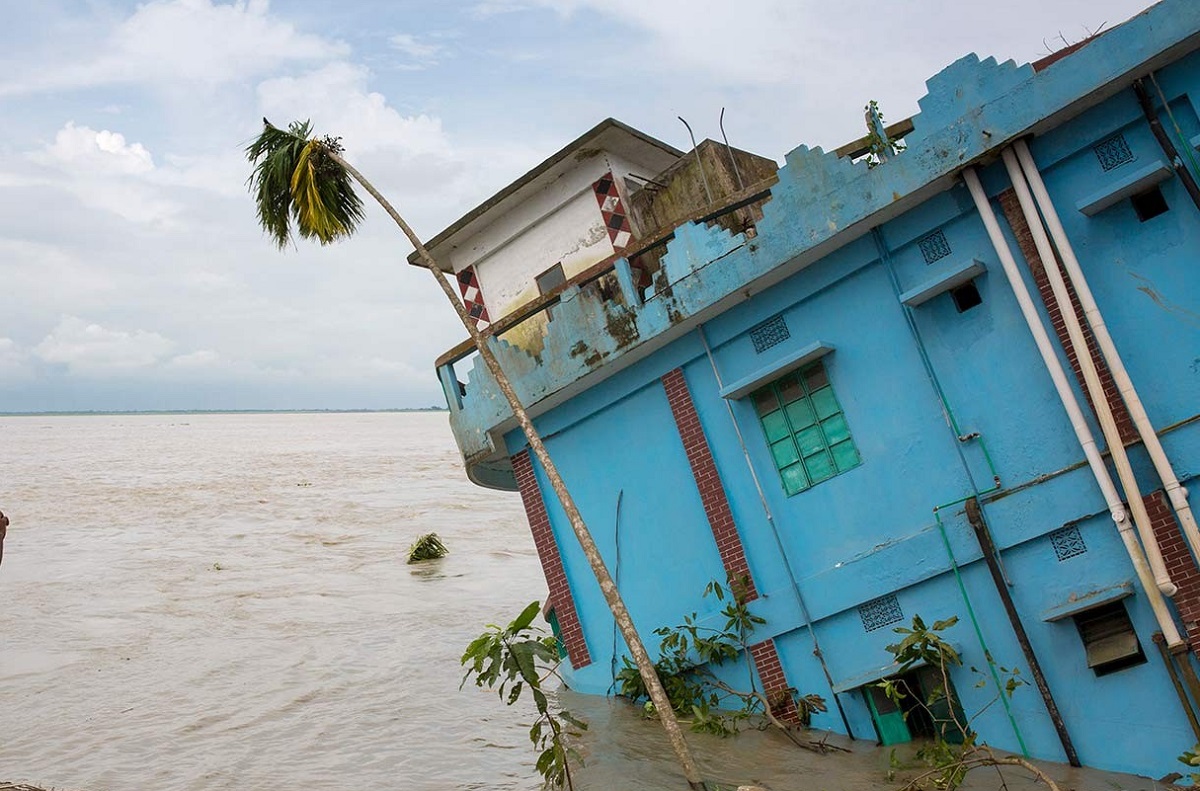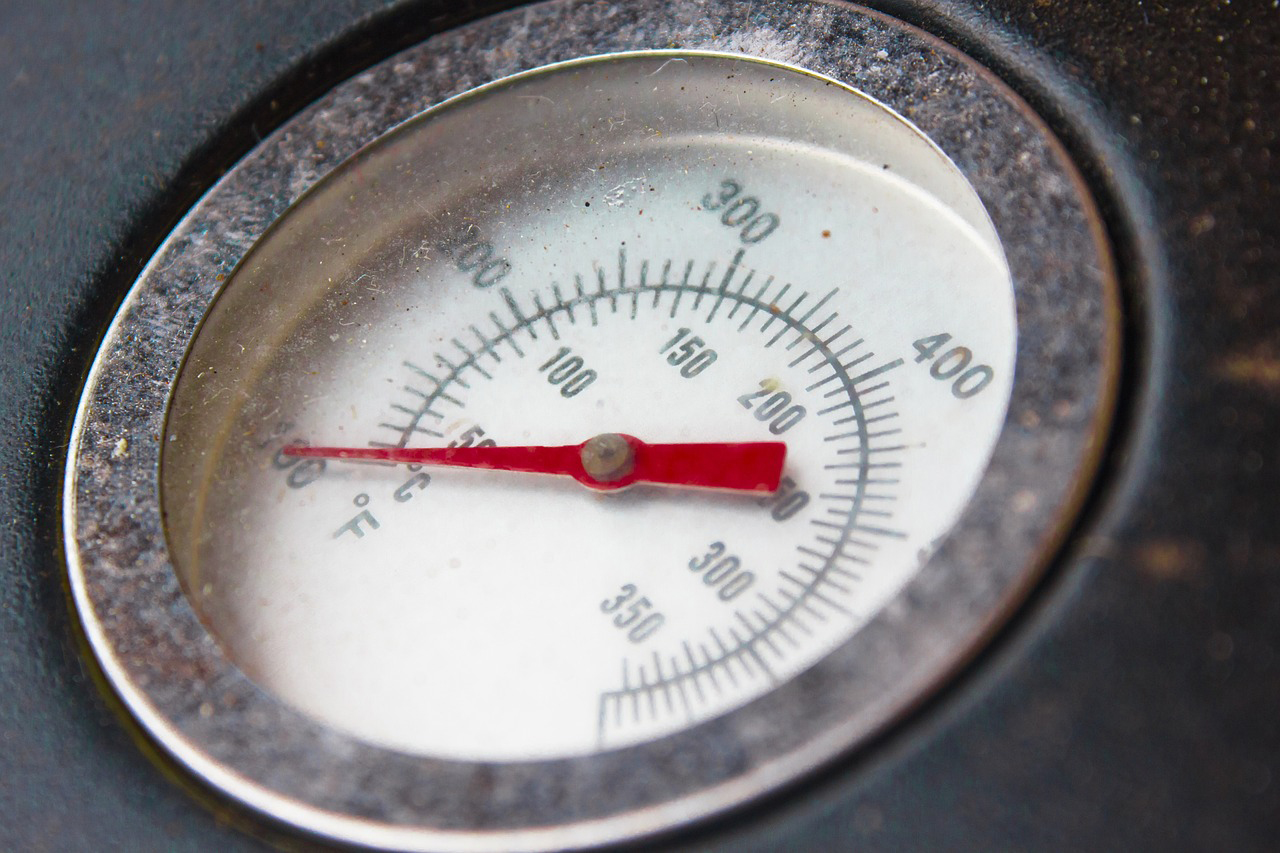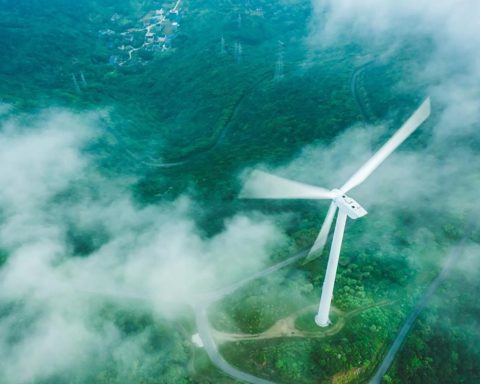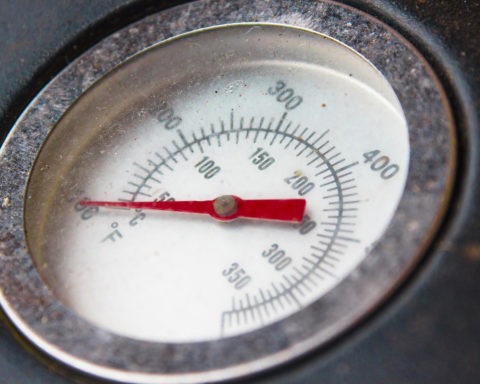Il existe un grave danger d’effondrement de la biosphère à cause du réchauffement et du dérèglement climatique. C’est la survie de l’humanité, et dans un premier temps des plus fragiles qui est en jeu. Contre ce danger, depuis 1981, les COP climatiques, les dirigeants du monde affirment lutter afin d’éviter une catastrophe climatique et écologique. Mais, le réchauffement continue inexorablement à s’élever. Quel est l’état de la situation écologique et socio-économique ? Quels sont les différents scénarios socio-écologiques pour le futur de l’humanité ? Quels sont les facteurs d’effondrements des civilisations ? Voilà les trois principales questions auxquelles le livre de Thierry Brugvin, « Effondrement, 20 scénarios possibles »**, tente de répondre. Il nous le présente, en exclusivité.
C’est autour de 2015 ou 2016, en découvrant un jour la carte édifiante publiée par la revue « New Scientist » sur « un monde plus chaud de 4° degrés » que j’ai véritablement pris conscience qu’il y avait pire encore qu’un monde décroissant ou en récession : un monde subissant le réchauffement climatique et son dérèglement. Il ne s’agissait plus seulement de ressentir un peu moins le froid de l’hiver et de subir un peu plus la chaleur de l’été… Dans cette carte, on peut observer que la France se recouvrait d’ocre, tel un pays aride dont le climat se révèle analogue au sud de l’Espagne, voire au nord du Maroc et seul le nord de l’hémisphère restait vert et plus ou moins cultivable.
En effet, dans un monde analogue au Moyen Age, l’humanité peut néanmoins encore se nourrir au prix d’un travail agricole laborieux. Cependant, lorsque la température terrestre s’élève trop, cette fois l’eau vient à manquer, la production agricole devient insuffisante, donc les famines apparaissent entraînant des millions de morts…
La majorité des ressources non renouvelables sera épuisée entre 2040 et 2090
L’épuisement des ressources non renouvelables de la planète est proche. En 2019, l’OCDE (Organisation de coopération de développement économique) estimait que l’extraction de ressources naturelles devrait augmenter de 111% (150% pour les métaux et 135% pour les minéraux) pour alimenter une croissance annuelle illimitée (1). En 2017, la consommation mondiale de pétrole était de 95 Mds de barils. Si on les stocke côte à côte, ces barils de 50 cm par 80 cm de haut représenteraient 40 000 km soit le tour de la terre. Si on les empile verticalement l’un sur l’autre, ils s’élèveraient à 760 000 km de haut. Et cela toute l’année (2).
Il s’avère impossible d’atteindre une croissance quantitative infinie dans un monde fini. Pourtant, « avec un taux de croissance de 2% (donc très bas) en 2000 ans, le PIB serait de 150 millions de milliards. En 2000 ans avec seulement 0,7% de croissance, il serait d’un million de fois le PIB actuel ! Or le taux de croissance moyen dans l’OCDE naviguait plutôt entre les 3 et 5% en moyenne » du moins avant la crise économique de 2008. En 2022, la croissance de l’économie mondiale était de 3,3%, comme au début des années 2000 où elle était en moyenne de 3 %. Or, avec un tel taux, « une économie double en 23 ans » et une croissance de 10 %, une économie double en 7 ans ». Cependant les ressources non renouvelables devraient être épuisées d’ici 20 à 50 ans.
En ce qui concerne les ressources d’énergie, elles devraient disparaître rapidement : le pétrole vers 2050, le gaz naturel autour de 2070, le charbon vers 2160. Concernant les métaux, les filons de fer seront à secs en 2090. On constate que la hausse des prix du pétrole génère un ralentissement de la croissance, puis une hausse des prix des denrées alimentaires. Quant au nucléaire pourra-t-il diminuer le réchauffement climatique ? Sans doute un peu, mais les réserves en uranium arrivent aussi à leur fin. De plus, l’énergie électrique n’est pas si verte actuellement.
Par ailleurs, avec un réchauffement de 2°C, la montée des eaux devrait impacter plus d’un milliard de personnes au XXIe siècle. En plus de la montée des mers, on observe aussi un risque croissant d’enfoncement des sols des métropoles. Mais il y a pire car le réchauffement climatique risque d’impacter gravement l’agriculture et donc d’engendrer d’immenses famines. En France, les records de températures pourraient largement dépasser 50 degrés d’ici à 2050 (4).
Le risque le plus important pour l’humanité concerne le réchauffement climatique
Or en 2021 la concentration de CO2 est 50 % plus élevée qu’en 1800, et la température moyenne à la surface de la Terre a déjà augmenté de 1,1°C. En 2021, l’Organisation météorologique mondiale et le Met Office britannique avertissent que « la probabilité d’atteindre un réchauffement de 1,5°C d’ici à 2025 s’élève désormais à 40 %. L’Accord de Paris de 2018 fixait un seuil de 1,5°C à ne pas dépasser avant la fin du siècle. C’était l’objectif le plus ambitieux fixé. Mais 75 ans avant l’échéance, nous devrions déjà le dépasser avec les conséquences catastrophiques que cela implique » (5).
Le réchauffement climatique engendre la montée des eaux qui vont inonder des zones densément peuplées et fertiles telles que les deltas du Nil et du Bengladesh, ce qui créerait des famines.
Le GIEC estime qu’un milliard de personnes seraient touchées par la montée des eaux au XXIème siècle avec un réchauffement de 2°C. Mais il se peut fort bien qu’il atteigne 4°C. Ce serait alors plusieurs milliards de personnes qui seraient touchées (6).
Pour ne rien arranger, le problème des sécheresses liées à la hausse des températures va impacter la production agricole et donc créer elles aussi d’immenses famines. Or au moins 50 000 personnes meurent de faim ou de malnutrition chaque année à cause du réchauffement climatique (7). D’autre part, le réchauffement climatique croissant va générer chaque année des famines en plus grand nombre encore. Selon le rapport sur la nutrition mondiale 2017, 815 millions de personnes se couchaient le ventre vide, soit une personne sur neuf en 2016. C’est un chiffre en augmentation par rapport aux 777 millions de personnes recensées en 2015. De plus, 50 millions d’enfants souffraient de la faim en 2017. Selon le Programme Alimentaire Mondial (PAM), plus 25 000 personnes, adultes et enfants confondus, mouraient chaque jour de famine et de causes apparentées, soit plus de 9 millions chaque année, en 2009 (8). Ce qui correspond à environ 80 % de la population de la région Île de France. Pourtant le futur devrait être pire encore, à cause de nouvelles sécheresses qui vont limiter la production agricole mondiale.
Fin 2020, la terre compte encore 690 millions de mal-nourris soit 8,9 % de la population mondiale dont 140 millions d’affamés ; 7 millions de personnes par an en meurent encore. Le directeur du PAM annonce que « la pandémie double les besoins, alors qu’elle bloque le transport des aides, en conséquence 135 millions de personnes supplémentaires seront touchées par la famine. Mais en 2021 cela pourra s’accroitre énormément.». » alerte-t-il (9).
Alors qu’il y a suffisamment de quoi nourrir chaque individu sur la planète, les inégalités socio-économiques mondiales génèrent une insolvabilité des plus pauvres. En 2008, les violentes crises financières, alimentaires, pétrolières et écologiques ont remis en cause l’ancienne place de l’humain sur la terre et dans la nature. Certains attendent du progrès technique, la solution à ces crises systémiques, tandis que la majorité des écologistes préfèrent la régulation de l’écologie par des normes et des lois.
L’humanité pourrait-elle survivre à une hausse des températures de 10,5°c en 2300 ?
Cette hausse figure parmi les prévisions du GIEC. Il s’agirait alors d’une température moyenne de 25,5°C. En 2016, la température moyenne sur la terre était de 15°C et celle de la France était de 15,6°C en 2014. De plus, la survie physique d’un humain dépend de la relation entre le taux d’humidité et de la température extérieure. Dans un désert à 25°degrés Celsius de moyenne, l’agriculture est possible dans une oasis. La ville de Biskra possède une température moyenne annuelle qui s’élève à 21,8°C, mais parvient à une forte production agricole. Ainsi, il existe des régions qui parviennent à produire de gros volumes agricoles dans des climats encore plus désertiques, mais seulement lorsque les nappes phréatiques sont suffisantes. Il faut donc en conclure qu’en matière de production agricole, le problème est moins le niveau de la température que le volume d’eau disponible. Or les carences en eau deviennent un grave problème pour des millions d’êtres humains dans la majorité des nations. C’est pourquoi, les guerres pour l’eau vont s’accroître, afin de pouvoir accéder et se partager l’eau des rivières et des fleuves.
Les limites écologiques vont faire diminuer la démographie mondiale
Le danger de la désertification provient d’une baisse drastique des ressources agricoles et donc alimentaires. Ce qui devrait conduire la démographie mondiale à s’effondrer selon le rapport Meadows dans le cadre du Modèle standard (business as usual)(10). De plus, le permafrost représente une véritable bombe à retardement climatique.
Malgré les discours pour diminuer le réchauffement climatique, l’empreinte carbone du numérique ne cesse d’augmenter. De même, la consommation de textile représente la 2e industrie la plus polluante après l’industrie pétrolière. Quant à l’impact du transport dans le réchauffement climatique, il s’avère important, mais pas majoritaire, car les émissions de carbone du transport représentent 14 % des émissions mondiales. Par ailleurs, les cargos émettent énormément de souffre, mais peu de CO2 proportionnellement à leur poids. Même si les grandes entreprises sont plus responsables des émissions de CO2, chacun d’entre nous dispose d’une part de la responsabilité proportionnelle à sa consommation. Au plan mondial, l’empreinte carbone par habitant est 2 à 3 fois trop forte pour être soutenable. Quant à l’empreinte carbone de la France et donc du français moyen, en 2023 s’avère 6 fois trop importante pour être soutenable.
Une empreinte écologique soutenable s’avère une condition de la survie de l’humanité
Depuis « les années 1950 l’empreinte écologique des Français a dépassé la capacité des ressources naturelles de la France à satisfaire leurs besoins » (11). Or on observe une forte corrélation entre le niveau de revenu et l’empreinte écologique. Certains pays comme Cuba, ne se révèlent pas très riches, mais ils disposent d’une empreinte écologique soutenable, tout en ayant un bon indice de développement humain (IDH). Thomas Piketty a montré que les émissions de CO2 des individus se révèlent proportionnelles à leurs revenus, donc que la responsabilité de l’empreinte carbone et écologique est en relation avec leur niveau de richesse. De plus, les inégalités de richesse s’accroissent et l’inégalité économique varie en fonction du pays de naissance. Or l’histoire des inégalités écologiques montre qu’elles proviennent aussi des inégalités économiques historiques. La responsabilité du réchauffement climatique varie selon les critères, la vision politique et ses intérêts nationaux. Il existe quatre niveaux de lutte des classes socio-économiques et écologiques : la lutte entre propriétaires et non propriétaires, la lutte pour le pouvoir d’achat, la lutte économique entre le nord et le Sud et la lutte écologique Nord Sud pour les dernières ressources non renouvelables.
La crise climatique accroît les famines et les migrations
Ainsi, le combustible des automobiles au Nord diminue la nourriture au Sud, du fait de la production mondiale d’énergie primaire dont les agrocarburants. Ainsi, se développe une forme de marché mondial de l’accaparement des terres agricoles dont le développement des agrocarburants contribue à affamer les plus malnutris. De plus, la quantité des poissons diminue dans le monde et certaines espèces sont en voie de disparition. La consommation de viande contribue au réchauffement climatique. Le monopole du contrôle des semences devient une arme alimentaire et commerciale. L’industrialisation de l’agriculture bénéficie aussi au capitalisme pétrochimique.
La biodiversité est en chute libre. Or elle s’avère indispensable à l’équilibre de l’écosystème et à une agriculture productive et résiliente. On relève que 32 % des espèces sont en recul au plan mondial. On le sait, l’effondrement des espèces et de la biodiversité touche en particulier les abeilles qui sont pourtant cruciales pour l’agriculture. Mais c’est bien l’humanité qui est la cause principale de la 6e grande extinction des espèces et donc de la chute de la biodiversité.
Sommes-nous dans l’anthropocène, le capitalocène, ou le bovidocène ? Non ce serait davantage le productocène, le productivisme capitaliste, socialiste ou communisme. Reste-il assez de terres cultivables à l’échelle mondiale actuellement et leur surface sera-elle suffisante pour nourrir l’humanité ? Oui car nous pouvons nourrir plus de 11 milliards d’humains, mais tous ne disposent pas de suffisamment de moyens financiers pour s’acheter de la nourriture. Pour cela il faudrait redistribuer les richesses. Cependant il y a aussi une concurrence entre le développement de l’agriculture et la déforestation. Car, la diminution du cycle de l’eau par la déforestation accroît le réchauffement climatique. Quant à ce dernier, il augmente le nombre de réfugiés dans le monde.
Malgré la trentaine de COP visant à réguler le climat, la situation ne fait que s’aggraver
C’est sans doute que la régulation du climat n’est pas nécessaire aux élites, mais aussi que les populations ne souhaitent pas changer leur mode de vie, car chacun aspire à consommer toujours plus, afin d’atteindre au moins le niveau de vie des classes situées au-dessus d’elles. On observe en effet une corrélation forte entre le niveau de revenu et l’empreinte écologique. Or seule une empreinte carbone et une empreinte écologique soutenable permettront la survie de l’humanité.
La responsabilité individuelle ou nationale vis-à-vis des dégâts sur l’environnement s’avère proportionnelle aux destructions causées et généralement aussi proportionnelle au niveau de la richesse donc de la consommation ou de la production. Mais cette responsabilité est aussi proportionnelle au pouvoir des élus, des technocrates et des citoyens à faire voter des lois environnementales et à la faire appliquer. La responsabilité écologique s’avère donc proportionnelle à deux facteurs, le pouvoir économique et le pouvoir politique, individuel ou collectif.
Chacune des grandes puissances accuse l’autre d’être la plus responsable du réchauffement climatique. Or la responsabilité de l’empreinte carbone varie en fonction des indicateurs choisis. Cela peut être les individus les plus riches (les 8,5 propriétaires, les 1%, les 5%, 10 %, les 50% les plus riches de l’humanité), les entreprises les plus polluantes, comme les pétroliers, ou les pays disposant de l’empreinte carbone la plus importante. Parmi les grandes puissances, les plus responsables des émissions de CO2 sont les Etats-Unis pour l’empreinte carbone par habitant, la Chine pour l’empreinte carbone par pays, et la Grande Bretagne pour l’empreinte carbone, depuis le début de l’ère industrielle en 1850. En effet, l’histoire des inégalités écologiques provient aussi de l’Histoire des inégalités économiques.
Quel sera le futur écologique de l’humanité ?
On relève différents scénarios écologiques pour l’humanité. Le GIEC propose 5 nouveaux scénarios pour le futur. Le scénario SSP1-1.9 s’avère le plus optimiste. Le GIEC y décrit un monde où les émissions mondiales de dioxyde de carbone tombent à zéro vers 2050. Dans le scénario SSP1-2.6 “ le deuxième meilleur scénario du GIEC “, les émissions mondiales de CO² sont fortement réduites mais moins rapidement. Dans le 3e scénario SSP2-4.5, le monde restera au milieu du gué. Dans le 4e scénario SSP3-7.0, le monde sera tiraillé par des rivalités nationales et suivra un chemin escarpé. Dans le 5e scénario SSP5-8.5, le développement du monde sera alimenté par des combustibles fossiles et sera un monde qui fonce sur l’autoroute, jusqu’à l’abîme.
Quant à l’ADEME, elle a imaginé 4 scénarios vers la neutralité carbone en 2050 : Scénario 1 : Génération frugalité (sobriété avec un peu de technologie) ; Scénario 2 : Coopérations territoriales (avec une légère sobriété et un peu de technologie) ; Scénario 3 : Technologies vertes (sans sobriété) ; Scénario 4 : Le pari réparateur (solutions technologiques sans sobriété).
Dès 1972, le rapport Meadows pour le club de Rome envisageait 11 scénarios dont 5 principaux, pour le futur de l’humanité en 2100 qui ont été actualisés périodiquement (12). Le premier scénario est lié à la diminution des ressources non renouvelables ou « business as usual ». Il y a ensuite le scénario lié à la croissance de la pollution. Puis le 3e scénario du contrôle de la pollution. Dans le 4e scénario, l’humanité décide de contrôler les naissances, la pollution et les ressources non renouvelables. Dans le 5e, tout est stabilisé, sauf les ressources non renouvelables (13). C’est ce dernier qui s’avère le plus réjouissant, mais c’est le 1er scénario que l’humanité suit actuellement. Ce scénario prévoit que la démographie n’atteindra jamais 11 milliards, mais seulement 7,8 milliards (14), car sa croissance cessera en 2030. Ceci parce que la production industrielle et agricole aura commencé à stagner autour de 2020. Or c’est en effet ce qui s’est passé. L’équipe de Meadows, n’avait pas prévu la crise du Covid en particulier mais la récession, oui. Hasard ou non, toujours est-il que cela fait 50 ans que ces prévisions tiennent la route (15 – 16).
Pour terminer la futurologie, rappelons les 6 autres scénarios pour le futur de l’humanité sur la planète, mais cette fois en relation entre les ressources technologiques et écologiques : 1) le scénario des cités ou états technologiques forteresses, 2) le scénario agricole sans technologie de pointe; 3) le scénario des centrales au thorium (donc à énergie moyenne, mais limitée par les métaux), 3-a) le sous-scénario à climat dérégulé et 3-b) le sous-scénario à climat régulé (donc à énergie moyenne, mais limitée par les métaux); 4) le scénario d’énergie abondante manquant de métaux ; 5) le scénario de l’abondance énergétiques et métalliques, dont 5-1) le sous scénario du capitalisme aux ressources abondantes ; et 5-2) le sous-scénario du communiste ou du socialiste démocratique aux ressources abondantes. Puis, 6) le scénario de la société décroissante (puis post-croissante) ; 6-1-1) la décroissance solidaire, volontaire et démocratique, 6-1-2) la décroissance libérale ou d’extrême droite. Concernant le 6e scénario, il existe des sous-scénarios de la décision politique de décroissance par la planification écologique, par les décisions autoritaires par un gouvernement mondial ou de plusieurs gouvernements nationaux, ou par la régulation incitative de la décroissance par la démocratie représentative ou par la décision politique prise par démocratie directe par le référendum. Enfin, il y a aussi des sous-scénarios des modalités de mise en œuvre du 6e scénario de décroissance solidaire et planifiée, par un contrôle numérique, par l’incitation, ou par la limitation des ressources individuelles des ressources individuelles (salaires, revenus, patrimoines…).
Pour tenter de prédire les sociétés futures autour de 2100, ces différents scénarios peuvent être résumés autour de trois scénarios majeurs fondés sur trois critères : le degré de probabilité, le niveau d’inégalités et la situation écologique et donc alimentaire. Ainsi il y a ainsi principalement les sociétés technologiques inégalitaires, mais dont l’existence s’avère peu probable car les solutions technologiques ne s’avèrent pas encore véritablement découvertes ou maîtrisées. Puis il y a les sociétés écologiques majoritairement égalitaires, mais dont la probabilité d’advenir reste aussi relativement faible par manque de désirabilité par la majorité. Enfin il y a les sociétés écologiquement fragiles et donc alimentairement insuffisantes, qui se révèlent aussi fortement inégalitaires. Or les scénarios inégalitaires s’avèrent les plus probables, car ils prolongent simplement les tendances dominantes actuelles mondiales au plan politique, socio-économique et écologique.
Quelles sont les causes de l’effondrement des sociétés et comment définir l’effondrement d’une société ?
En fonction de la définition de l’effondrement, l’interprétation et l’analyse d’une étude de cas se révèlera différente. L’effondrement d’un type de société conduit à sa disparition ou à son remplacement, mais elle peut résulter d’une révolution, ou d’une innovation. D’ailleurs, il faut distinguer la révolution de l’effondrement. Lorsqu’une ancienne civilisation s’effondre à l’occasion d’une révolution, s’agit-il d’un effondrement ? Non, car dans une révolution la majorité des acteurs sociaux de cette société ou civilisation restent présents.
Le chercheur Jared Diamond explique les effondrements à partir de cinq facteurs principaux. Selon Diamond, le premier facteur d’effondrement « concerne les dommages que les individus infligent à leur environnement.» Le second facteur identifié par Diamond relève des changements climatiques. Le troisième facteur d’effondrement qu’il met en évidence est induit par « des conflits avec d’autres sociétés.» Le quatrième facteur d’effondrement consiste dans les rigidités idéologiques et culturelles des élites. Le cinquième facteur est déterminé par la réduction du soutien apporté dans les relations commerciales avec d’autres sociétés (17). Mais il existe un autre facteur d’effondrement, qui n’a pas été abordé par Diamond, celui des inégalités. Or, à la suite de Marx qui priorise les causes économiques, Motesharrei avec son Modèle HANDY considère que ce sont les inégalités économiques qui accélèrent le déclin des sociétés. C’est ainsi qu’il explique l’effondrement de la société Maya.
Par ailleurs, pour le chercheur Joseph A. Tainter, la complexité organisationnelle se révèle un facteur de fragilisation d’un système. Or il existe un équilibre optimal entre efficacité et robustesse dans la taille d’une société ou d’un système. Il y a donc rarement un seul facteur ou secteur de la société, qui explique un effondrement ou une révolution mais plutôt une combinaison de facteurs.
Comment tenter d’éviter l’effondrement ?
Pour y répondre, il existe des propositions des courants de pensée de l’écologie politique. Cependant les solutions actuelles du courant néolibéral mondialisé pour réguler le climat s’avèrent peu efficaces, puisque le dérèglement s’accentue sans cesse. La politique de compétition libérale mondialisée s’oppose à une coopération climatique internationale efficiente. D’ailleurs, les mécanismes de régulation mondiale du carbone se révèlent très peu efficaces, mais les plus riches ne veulent pas véritablement les changer. Or, la régulation du climat ne se révèle pas vraiment nécessaire aux élites, qui sauront plus longtemps que les autres en repousser les conséquences pour eux-mêmes. Mais, il existe d’autres propositions politiques que celles des libéraux. Certains considèrent que la régulation du libéralisme économique, ne suffira pas à réguler le climat, car le problème serait le capitalisme. D’autres répondent que, c’est surtout le productivisme, qui pousse à la productivité, au profit et à la consommation et que le communisme lui-même s’est révélé aussi productiviste, comme le capitalisme libéral. Il est vrai que le capitalisme social ou écologique ne perdure jamais très longtemps, car les grands capitalistes, c’est-à-dire les entreprises transnationales ne veulent pas être trop régulée dans leur liberté. Le problème relève donc à la fois du productivisme communiste et du productivisme capitaliste libéral, avec sa liberté compétitive, fondamentalement non coopérative.
Il y a donc différentes orientations qui s’inscrivent dans le cadre des grands systèmes politico-économiques et écologiques. Il y a celles de l’écologie sociale, de la décroissance, des effondristes, de l’écosocialisme, de l’économisme, de l’écologie libérale et de l’écologie extrême-droite. L’alternative relève aussi d’une transformation de la psychologie individuelle et collective. Il existe une multitude de solutions pour agir contre le dérèglement climatique et la fin des ressources non renouvelables.
Parallèlement à l’engagement individuel, l’action collective ou les stratégies des partis politiques ou des associations face aux problèmes écologiques, il existe 5 principales attitudes. Il y a les réalistes, parfois pessimistes envers les irréalistes, parfois optimistes, mais on observe aussi les combatifs face aux défaitistes. Il y a ensuite les combatifs optimistes, les combatifs pessimistes, les défaitistes, qui sont par nature pessimistes. Concernant les très graves problèmes pour lesquels les probabilités de réussite se révèlent relativement faibles, il semble que l’attitude la plus constructive soit d’être combatif, sans être trop optimiste. Ceci afin de ne pas minimiser l’effort à entreprendre et de ne pas sombrer dans l’angélisme des petites actions individuelles pour protéger l’environnement.
Psychologiquement, il vaut mieux agir et éventuellement échouer que subir un effondrement extérieur, voire intérieur sans avoir tenté d’agir. L’abattement s’avère la pire des solutions. Pour prédire ce qui va arriver à l’humanité, nous pouvons utiliser la métaphore d’un train lancé à pleine vitesse qui arrive trop vite dans un virage bordé d’un mur. Plus le conducteur du train freine, plus la population fait d’effort pour décroître et infléchir la direction prise, moins le train frappe violemment le mur et plus il sera alors en mesure de poursuivre sa progression, avec le moins de wagons perdus possible. Dans notre cas, c’est-à-dire avec le moins de destruction écologique, de décès par la famine et de guerres possibles.
Thierry Brugvin, Docteur en sociologie – Enseignant-chercheur en psycho-sociologie à l’Université de Besançon et psychothérapeute
** »Effondrement, 20 Scénarios possibles – Inégalités économiques, crise écologique, incohérences politiques » Editions Yves Michel, 2024
(1) OCDE, Global Resources Outlook to 2060, OCDE, 2019
(2)COUZINER Adrien, Etat des lieux sur le risque d’effondrement de la société thermo-industriel, ADRASTIA, Novembre 2018
(3) LATOUCHE Serge, Le pari de la décroissance. 2006, Fayard, 302 p.
(4) ENVIRONMENTAL RESEARCH LETTERS, 19 juillet 2020
(5) WMO, WMO Global Annual to Decadal Climate Update for 2021–2025, WMO, mai 2021, in Média Citoyen, « L’ONU prévient : nous nous dirigeons vers un enfer climatique », juin 2021.
(6) AFP, RELAXNEWS, FUTURA, Réchauffement climatique : la montée des eaux sera bien plus élevée et rapide que prévu » 13/12/2021.
(7) BARRAU Aurélien, Le plus grand défi de l’histoire de l’humanité, Robert Laffont, 2020.
(8) FAO, L’état de l’insécurité alimentaire dans le monde, FAO, 2013
( 9) LE BOUCHER Eric, « L’intolérable retour de la famine dans le monde », Les échos, 11 déc. 2020.
(10) TURNER Graham, On the Cusp of Global Collapse? Updated Comparison of The Limits to Growth with Historical Data, GAIA21/2(2012) p.116 – 124. TURNER,Graham. Is Global Collapse Imminent? MSSI Research Paper No. 4, Melbourne Sustainable Society Institute, The University of Melbourne, 2014.
(11) CANFIN Pascal, « Un modèle de croissance insoutenable », Alternatives économiques, Fév. 2010
(12) TURNER Graham, 2014, p. 7.
(13) MEADOWS 1972, Fig 46;
(14) Correspondant à la valeur normalisée d’environ 0,47 du modèle standart (BAU) de Turner (2008)
(15) PISON Gilles, Tous les pays du monde, Population et Sociétés, numéro 525, septembre 2015.
(16) Ce qui correspond à la « valeur normalisée » de 0,43 du rapport Meadows réajusté par TURNER, G. M. “A comparison of The Limits to Growth with 30 years of reality”, Global Environmental Change, 18, pp. 397-411, 2008
(17) DIAMOND Jared, Effondrement, Comment les sociétés décident de leur disparition ou de leur survie, Paris, Gallimard, 2006.DIAMOND, 2006.
(18) NAFEEZ Ahmed. « Nasa-funded study: industrial civilisation headed for ‘irreversible collapse’? », Earth Insight, The Guardian, 14 March 2014. in WARSCHAWSKI Dror, La fin du monde : la faute à qui ? Genève, Le courrier, 6 mai 2014
Photo d’en-tête : Perte d’une maison en bord de rivière à Soriotpur, au Bangladesh /août 2018 — Photo Chowdhury Zakir Hossain/Barcroft Media/Abaca.












